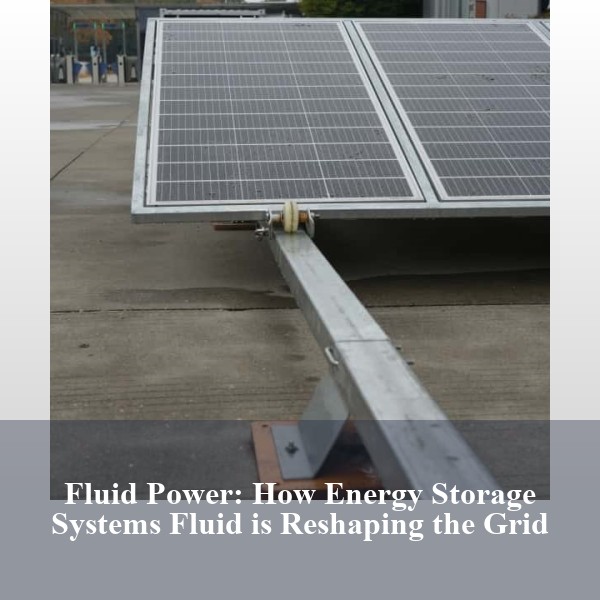Fluid Power: How Energy Storage Systems Fluid is Reshaping the Grid

Why Your Electricity Grid Needs a Liquid Lunch
A Texas heatwave causes wind turbines to stall just as everyone cranks up their AC. Meanwhile, in California, solar farms are drowning in unused midday energy. Enter energy storage systems fluid - the unsung hero that could prevent both scenarios. These liquid-based solutions aren't just changing the game; they're rewriting the rulebook for renewable energy storage.
The Fluid Frontier: Types of Liquid Energy Storage
When we talk about fluid-based energy storage systems, we're not discussing your grandmother's water heater. Here's what's making waves:
- Flow batteries (the chemistry nerds' favorite)
- Pumped hydro storage (grandpa still has tricks)
- Molten salt systems (solar's spicy sidekick)
- Cryogenic energy storage (because why not freeze air?)
Liquid vs. Lithium: The Great Storage Showdown
Let's settle this like adults. While lithium-ion batteries hog the spotlight, fluid energy storage systems offer three knockout punches:
1. Endurance That Would Make Marathoners Jealous
The Hornsdale Power Reserve in Australia (Tesla's lithium baby) can power 30,000 homes for... 1 hour. Now look at China's Dalian Flow Battery - it's been humming along for 12+ hours daily since 2022. Fluid systems don't just store energy; they marathon through energy droughts.
2. Fire Safety That Doesn't Require a Firetruck
Remember those exploding e-scooter batteries? Fluid systems laugh in the face of thermal runaway. The Vanadium redox flow battery at UMass Boston survived 1,000 charge cycles without so much as a sweaty electrolyte.
3. Second-Life Options That Don't Involve Landfills
When lithium batteries die, they become toxic paperweights. Fluid systems? Their electrolytes can be recycled indefinitely. It's like a vodka martini - shake (or stir), reuse, repeat.
Real-World Fluid Heroes Making Waves
Enough theory - let's talk cold, hard cash and results:
- Germany's Liquid Air Gamble: Their 250MWh cryogenic storage plant in Hamburg can power 50,000 homes overnight using nothing but liquefied air and leftover industrial heat
- California's Salty Secret: The Crescent Dunes Solar Energy Plant stores enough molten salt to power 75,000 homes after sunset (take that, solar skeptics!)
- Australia's Flow Battery Bonanza: The Victorian Big Battery now includes a 300MW fluid system that outlasts its lithium counterparts 3:1 during bushfire seasons
The Elephant in the Storage Tank
Let's address the viscous truth - fluid systems aren't perfect. Early flow batteries had efficiency numbers that would make a high school chemistry student cry (looking at you, 2015 vanadium systems with 65% round-trip efficiency). But fast forward to 2024, and we're seeing new organic electrolytes hitting 85%+ while costing less than a Tesla roof tile.
Future Fluid Trends: More Exciting Than a Netflix Cliffhanger
What's next in the fluid energy storage systems pipeline? Hold onto your lab goggles:
- Nanofluids: Particles so small they make bacteria look like Godzilla
- AI-Optimized Electrolyte Cocktails (think ChatGPT meets Marie Curie)
- Gravity-Assisted Liquid Systems (combining pumped hydro with maple syrup viscosity)
The Viscosity-Versatility Sweet Spot
Recent MIT studies show certain non-Newtonian fluids could double as structural components. Imagine your house foundation storing energy like a giant fluid battery - it's not sci-fi anymore. The Swiss are already testing this in Zurich's new eco-district.
Why Utilities Are Getting Fluid Curious
Duke Energy recently joked they're "swiping right" on fluid storage after their latest lithium fire drill. The numbers back this flirtation:
- 42% lower LCOE than lithium for 8hr+ storage
- 70% faster permitting (no explosive materials = happier regulators)
- Ability to use existing fossil fuel infrastructure (that pipeline might pump electrolytes tomorrow)
As we ride this liquid energy wave, one thing's clear: The future of grid storage isn't just solid - it's deliciously fluid. And for those still betting on lithium? Let's just say they might end up all charged up with nowhere to flow.
- Pre: What Is the Storage Form of Energy in Humans? The Fuel Tanks You Never Knew You Had
- Next: Energy Storage in North America: Why San Diego Is Leading the Charge
Related Contents

Why Lithium-Ion Grid-Scale Energy Storage Systems Are Reshaping the Power Game
California's grid survived a historic heatwave last summer not just because of solar panels, but thanks to football-field-sized lithium-ion grid-scale energy storage systems kicking in like superheroes after sunset. These massive battery parks - the Swiss Army knives of energy infrastructure - are quietly revolutionizing how we keep lights on. Unlike your grandma's lead-acid batteries, these systems offer enough juice to power 300,000 homes for four hours. Now that's what I call an energy glow-up!

How Energy Storage Systems Keep Power Systems Stable in the Modern Grid
It's Super Bowl Sunday, and millions of TVs suddenly surge to life across America. Meanwhile, a storm knocks out three wind turbines in Texas. Yet your lights don't even flicker. Why? Say hello to energy storage systems that keep power systems stable - the unsung guardians of your Netflix marathons and late-night pizza cravings.
Warning: imagejpeg(/www/wwwroot/sphoryzont.edu.pl/images/upload/Home Energy Storage RA48100S/RA51100S/WA48100S/WA51100S Weli Power1771.jpg): Failed to open stream: No such file or directory in /www/wwwroot/sphoryzont.edu.pl/kiss.php on line 607

Weli Power Home Energy Storage Systems: Your Gateway to Energy Independence
traditional power grids are about as reliable as a chocolate teapot in summer. Enter Weli Power's RA48100S and WA51100S series, the Swiss Army knives of home energy storage. These systems don't just store juice; they're rewriting the rules of household energy management with industrial-grade performance packed into residential-friendly designs.
